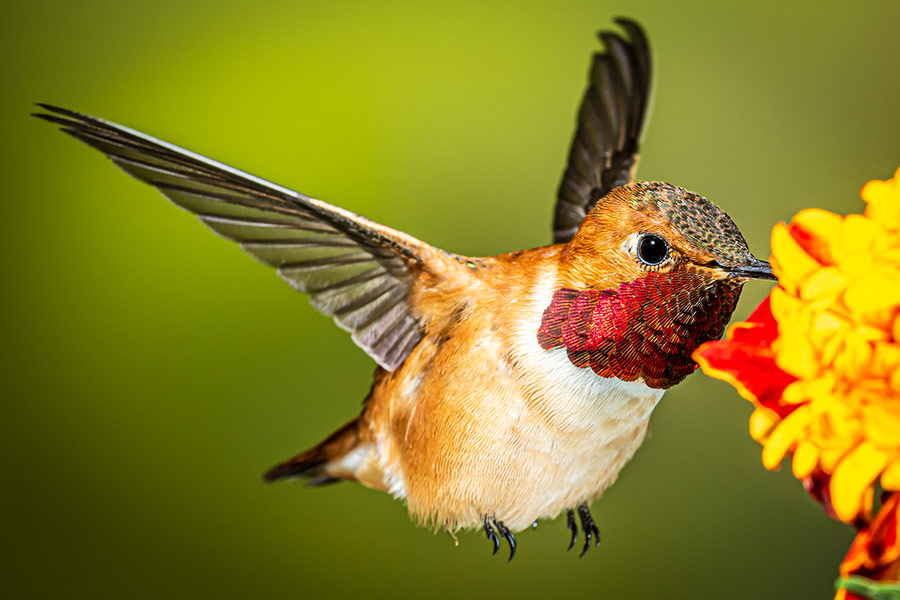See hummingbirds up close at unique DWR event
Vernal — As hummingbirds are migrating through Utah this summer, you've most likely witnessed a few eating at a feeder or enjoying some other source of nectar for a quick meal. If you want to see these incredible birds up close, you should consider attending an upcoming Utah Division of Wildlife Resources event in northeastern Utah.
People typically only see five different species of hummingbirds in Utah: black-chinned, broad-tailed, calliope, rufous and Costa's. The most commonly seen species are broad-tailed and black-chinned hummingbirds. But if you're lucky, you can also spot the smallest bird native to North America — and a surprisingly long-distance migrant — the calliope hummingbird. This bird weighs as much as a penny and can travel up to 5,600 miles in a single year.
The DWR is partnering with retired Bureau of Land Management Biologist Terry Tolbert and U.S. Forest Service Biologist Lisa Young to host a hummingbird banding demonstration on Saturday, August 3 from 7-11 a.m. The free event will be held at the Red Canyon Lodge at 2450 Red Canyon Road in Dutch John.
During the event, the researchers capture the hummingbirds and then place a small band on one leg of each bird. These bands — little more than thick aluminum foil — are stamped with a unique number that will identify each bird throughout its lifetime. The information gathered from the banding efforts helps biologists learn more about the birds' migration patterns and other crucial data.
"It's a rare and unique opportunity to see Utah's tiniest pollinating birds in hand, while watching biologists gather baseline data to determine strategies for conserving these birds, their habitat and future research needs," DWR Northeastern Region Outreach Manager Tonya Kieffer-Selby said. "The population status of many hummingbird species is unknown. These banding efforts help educate our local community, and also help us collect information that may be crucial for making future conservation and management decisions."
DWR biologists and staff will be available to explain the bird-banding process and to answer questions about hummingbirds during the event. Participants are encouraged to bring a camera to take pictures of the hummingbirds. If you attend, you may also want to stop at the nearby Red Canyon Visitor Center. It's a place where you can see other species of birds, and there's a good chance of spotting the bighorn sheep herd that resides near the Red Canyon Overlook.
"At this location, we're hoping to see and band rufous hummingbirds, which typically migrate through Utah in July as they travel from Canada and Alaska," Kieffer-Selby said. "Rufous hummingbirds are a bright copper/orange color and are often found at these higher elevations, aggressively fighting over nectar resources, like Indian paintbrush and other local flowers. We'll likely capture some broad-tailed and black-chinned hummingbirds during the event, too."
Over the last three years, biologists have banded over 200 hummingbirds — including four different species — at this event.
While the event is free, space is limited, so participants should sign up in advance on Eventbrite.
Attracting and feeding hummingbirds
Most hummingbirds migrate to warmer climates during the cold winter months and return north in the summer. Many travel thousands of miles in a single year during their annual migration cycle, and they are a welcome sight when they arrive in Utah. Feeding hummingbirds is fun for all ages and helps give a little extra boost to the high metabolisms of these world travelers.
They are excellent pollinators and primarily feed on flower nectar, so planting native plants — like penstemon and bergamot — is a great way to attract them to your yard. The agastache plant — also known as hummingbird mint — is another popular plant for pollinator species and can be found at most local nurseries.
Hummingbirds are highly attracted to the color red because most red flowers produce the highest and "tastiest" sugary nectar. However, this can also result in confusion for these tiny flyers at times, and they often get trapped in garages, where they get disoriented and sometimes die without intervention to get them out.
"This unfortunately happens from time to time," Kieffer-Selby said. "If you find a hummingbird in your garage, the best thing to do is to offer it a feeder by hanging one near the ceiling, and try not to stress the bird out. Sometimes, they will fly out at dusk if the garage door is open, but if they don't, you can always call your nearest DWR office for assistance in removing the bird."
In addition to nectar, hummingbirds also consume small insects and spiders for protein, so be aware of the chemicals you spray around your nectar sources.
If you are planning to install hummingbird feeders near your home, there are a few things to know.
"Many stores sell a premade 'red-dye' feed, but be aware that may not be the healthiest option for these birds," Kieffer-Selby said. "A simple 4-to-1 water and sugar solution in a traditional red-colored hummingbird feeder is often the more cost-effective and safe way to feed them and is better for the hummingbirds, overall."
For more information about the upcoming event, call the DWR's Northeastern Region office at 435-781-9453.

















